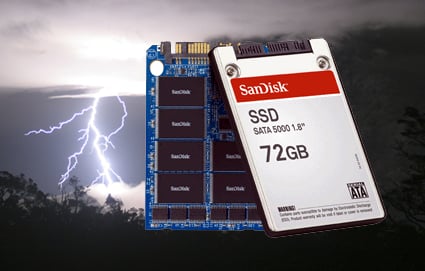

This battleground is getting hotter and hotter. Storage vendor SanDisk unveils its secret juice of ExtremeFFS.
El Reg reporting:
The flash is multi-threaded, incorporating a non-blocking architecture, so that the 4 to 10 channels from the controller to the NAND chips can be doing different things simultaneously. They can be used for reading, writing or garbage collection.
Think of garbage collection as being akin to checking the bookshelf and removing unwanted books thus creating empty space. Or think of the Wallace and Grommit cartoon where new railway track is continuously being laid down in front of a speeding locomotive. That's what the garbage collection does; create fresh track for the speeding (writing) locomotive by pulling up used track from behind the train.
So there are always, or should always be, empty pages for small random writes to be written into quickly without having to do an erase before the write. That's been done already in the background. Without this page-based algorithm every random write would need a block-level operation and take 100 milliseconds instead of, for example, one.
In effect, SanDisk has accelerated random writes by avoiding the need to erase flash for the write data before writing it.
Sequential writes are not accelerated because they operate at block level already as the files are typically large, images from digital cameras, etc.
SanDisk has also added a process whereby pages that are often accessed sequentially are placed contiguously so that their access is speeded up.
The net effect of ExtremeFFS according to SanDisk is that SSDs are now much more suitable for Windows use because the thousands and thousands of small writes, sub-block size, that Windows makes are accelerated through the new page-level algorithm. This should show up as greatly improved benchmarks for Windows SSD-using systems
Source
Comments
Post a Comment